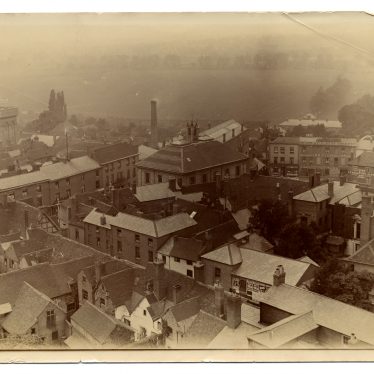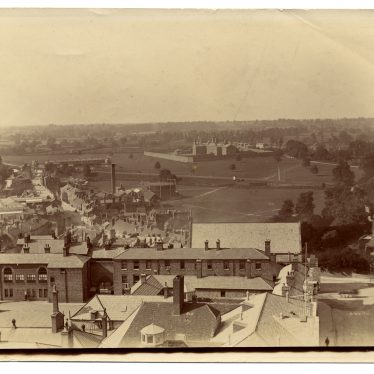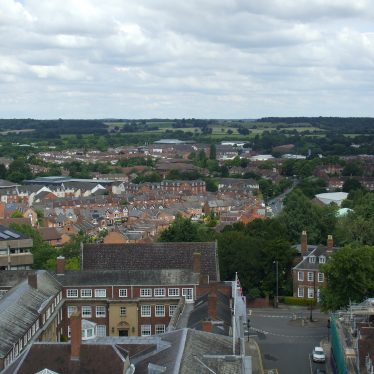These stunning photographs from the top of St Mary’s Church Tower in Warwick were taken by Dr Hubert Tibbits.
Twice Mayor of Warwick
Dr Hubert Tibbits followed both his father’s and grandfather’s footsteps by participating in the official life of Warwick. He was born in 1868, the seventh child of Dr John Tibbits J.P., himself four times Mayor of Warwick.1 His grandfather, Mr William Tibbits was Town Clerk from 1801 to 1827 and made mayor in 1827.
Dr Hubert Tibbits’ official life began in 1898 when he served for three years on the Town Council. In 1919, he was appointed as a member of the Warwick Borough Bench of Magistrates and was elected as Mayor in 1921, a position he held until 1923. This role involved greeting His Royal Highness the Prince of Wales (later King Edward VII) on his official visit to Warwick in June 1923.
A foggy afternoon
Mayoral dignity, however, was not always easily maintained. A favourite story of his was an account of traipsing along the Coventry to Warwick road in full regalia on a foggy afternoon after attending a special Sunday service at Coventry Cathedral. The car he was travelling in along with the Mayoress and Town Clerk ended up in the ditch. No-one was harmed, but all the passengers (along with a passing Major Forbes who stopped to offer directions) were forced to make their own way back to Warwick on foot (though apparently the Mayoress was able to board a bus just after Kenilworth). He said:
we kept meeting a lot of people under the lamps, and as we emerged out of the fog into the light there was a sudden silence followed by an awful howl of laughter.
Professional life
Dr Tibbits went to Warwick School and Edinburgh University, training at the Royal College of Surgeons and becoming a licentiate of the Royal College of Physicians. He eventually succeeded to the family practice. After the death of his father in 1891 he became a medical officer of the Warwick Dispensary, and later became the District Medical Officer.
Dr Tibbits was medical officer at Warwick Prison for 20 years (continuing after it closed as a prison and became a State Inebriate Institution, and later a girls’ institution). During his time at the prison, he attended imprisoned suffragettes (who would go on hunger strikes) and the execution of four prisoners.
During the First World War, when the prison was temporarily closed, he examined recruits at Budbrooke Barracks and worked as a medical officer at the Work Centre for Conscientious Objectors, many of whom were housed at the prison.2
Interest in heritage
Despite an active official and professional life, Dr Tibbits had a deep interest in maintaining Warwick’s heritage. His newspaper obituary stated that:
His mind was a storehouse of local history and of worthies who have passed on, but far from living in the past he always had a very keen concern in current affairs… he was always anxious to preserve any old records and features which formed a link with the past.
Personal life
Dr Tibbits married Lucy Harman in 1902 and they had four children (three sons and one daughter). His son, Stephen, would follow his father’s footsteps; he carried on the family practice and became HM Coroner for the Central District in 1942.
Dr Tibbits died at 21 Jury Street, Warwick – the family home – on Christmas Day 1933, aged 65.
More of his photos (along with the same view now) can be found at the following link.
Footnotes
1 Between 1870 and 1872 and again between 1877 and 1879.
2 See Warwickshire County Record Office reference CR 4800 for letters from White Hall received by Dr Tibbits regarding his work as medical officer at the Work Centre for Conscientious Objectors and subsequent medical assistance after the centre’s closure [1917-1918].
References
Obituary of Dr Hubert Tibbits, Warwick & Warwickshire Advertiser & Leamington Gazette, Saturday 30 December 1933 (Available to view at the Warwickshire County Record Office).

![St Nicholas, views over St Nicholas Meadow [now Park] and Jury Street [including house of Dr Tibbits] with Myton Road and King's School in distance St Nicholas, views over St Nicholas Meadow [now Park] and Jury Street [including house of Dr Tibbits] with Myton Road and King's School in distance, c. 1895. | Image by Dr Hubert Tibbits. Warwickshire County Record Office reference PH1298/1/4](https://d23iiv8m8qvdxi.cloudfront.net/wp-content/uploads/2016/07/TD16_01-Jury-Street-374x374.jpg)
![St Nicholas, views over St Nicholas Meadow [now Park] and Jury Street [including house of Dr Tibbits] with Myton Road and King's School in distance St Nicholas, views over St Nicholas Meadow [now Park] and Jury Street [including house of Dr Tibbits] with Myton Road and King's School in distance, 2016. | Image courtesy of Benjamin Earl](https://d23iiv8m8qvdxi.cloudfront.net/wp-content/uploads/2016/07/TD16_01-Jury-Street-now-374x374.jpg)










Comments
Add a comment about this page